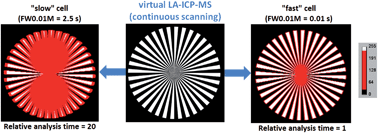Angular resolution dependency in 2D LA-ICP-MS mapping – the case for low-dispersion laser ablation cells
Abstract
In LA-ICP-MS imaging mostly lateral resolution is considered, but this work will show that linear artifacts with an angular aspect to the line scan direction may have a different spatial resolution, depending on the blur introduced by LA sampling and aerosol washout/transfer. This implies that upon scanning an irregularly shaped artifact, the spatial resolution in different locations may vary, the severity of which will be a function of the amount of “smearing” induced by the LA-ICP-MS system, invariably related to the design of the LA cell and aerosol washout/transfer efficiency. As reported previously (DOI: 10.1021/acs.analchem.6b02052), blur can be expressed as a convolution of the input image (representing the 2D elemental distribution) with point (PSF) and line (LSF) spread functions associated with ablation crater profiles and ICP-MS profiles of single pulses, respectively. Based on empirically derived PSFs and LSFs, and using a numerical calculation approach, the continuous-scanning LA-ICP-MS output of an angular-sensitive radial resolution target (Siemens star) was simulated to visualize the angular resolution dependency associated with ablation cell characteristics.

- This article is part of the themed collection: JAAS Recent HOT articles

 Please wait while we load your content...
Please wait while we load your content...